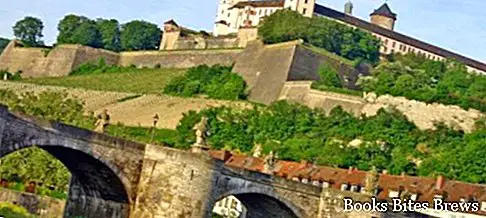What to see in Wurzburg, itinerary including the main monuments and places of interest, including Residenza, where there are frescoes by Tiepolo, Marienberg Fortress and Duomo.
Tourist information
City of Bavaria in Germany, Wurzburg is one of the stops on the Romantische Strasse, the famous romantic road, situated in a picturesque position on the river Main among the hills full of vineyards.
The town, the episcopal and university seat, experienced the period of greatest splendor between the seventeenth and eighteenth centuries, when it was enriched with magnificent buildings in the Italian Baroque style.
From 742 Wurzburg was a bishopric, in 1168 it was transformed into an independent duchy governed by the bishop, by the emperor Federico Barbarossa, who in 1156 had celebrated his wedding here with Beatrice of Burgundy.
The city and the annexed territory remained so structured until 1806, when it was secularized by Napoleon, then, from 1806 to 1814, it was governed by Archduke Ferdinand I of Tuscany, after which it passed to the kingdom of Bavaria.
What see
The Wurzburg Residence is a splendid palace, built between 1720 and 1744 as a residence for princely bishops.
Important architects and artists worked on this marvelous Baroque project, directed by the brilliant Balthasar Neumann.
Of particular interest is the monumental staircase, one of Neumann's masterpieces, and a large fresco by Tiepolo.
The ancient Alte Mainbrücke bridge, dating from the twelfth century, was destroyed by a flood and rebuilt between 1473 and 1543, while in the Baroque era it was adorned with twelve statues of saints.
Rathaus is the town hall of Wurzburg, once the residence of the bishop princes, whose original form dates back to the thirteenth century, of which it preserves the lower floor and the first floor, while the second floor, in Gothic style, is from 1453, the other two floors are Renaissance.
The Cathedral of St. Kilian, a Romanesque building dating back to the 11th century but rebuilt after the Second World War, has an interior with Baroque stuccos and numerous works of art.
Recommended readings- Dresden (Germany): what to see
- Octoberfest (Germany): beer festival in Munich
- Stuttgart (Germany): what to see
- Hamburg (Germany): what to see in the main port
- Hohenfurch (Germany): what to see
To the left of the Cathedral is the Neumunster Church, whose construction dates back to the thirteenth century.
Enlarged in the eighteenth century with a huge dome, the exterior has a spectacular Baroque facade.
In the west crypt there is the tomb of San Killian, patron of Franconia.
The Marienberg fortress stands in a dominant position, on a fortified site since the Celtic era where, in 704 AD, the first church of Wurzburg was erected.
The first fortification around the religious building dates back to the thirteenth century, while extensions and remodeling were carried out several times during the Renaissance and Baroque periods.
This was the fortified seat of the prince bishops, until the construction of the residential building.
Some buildings on the ramparts house the Mainfrankisches Museum, which houses an interesting Franconian art collection.
In the Kulturspeicher Wurzburg Municipal Art Museum there are two separate art collections, the municipal collection and the Peter C. Ruppert Collection of European art, focused on the period from the Second World War to today.
The municipal collection displays regional works of art of various types.




